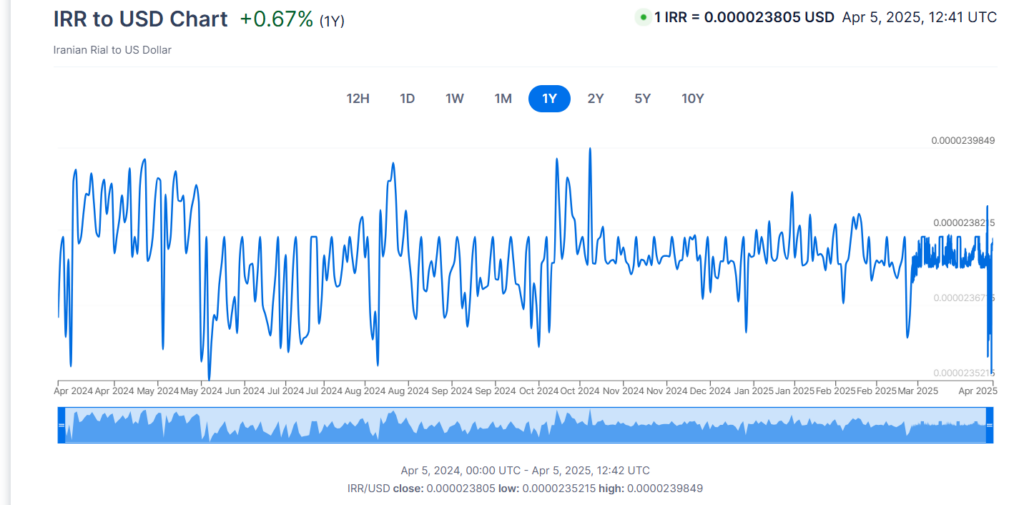In this post:
- When the Iranian markets reopened following a lengthy break, the value of the Iranian rial fell to 1,043,000 to the US dollar.
- Although Iran is amenable to indirect discussions, Trump has written to Iran’s Supreme Leader, Ayatollah Ali Khamenei, in an attempt to initiate direct negotiations between Washington and Tehran.
- Iranians are hoarding cryptocurrency, gold, automobiles, and hard currency.
As Iranians went back to work on Saturday after the holiday, Iran’s rial currency fell to a record low compared to the US dollar. A dollar now costs more than a million rials. This is just the beginning, as relations between Washington and Tehran will probably continue to rise.
The exchange rate fell to more than 1 million rials during Nowruz, the Persian New Year, when currency shops were closed. Only informal traders were present on the streets at this period. The market was further strained by the fact that individuals were not working.
However, the rate fell even more, to 1,043,000 to the dollar, rather than rising again. The new low is therefore probably here to stay.

The majority of Iran’s money markets are situated on Ferdowsi Street in Tehran, the country’s capital, and as a result, several traders shut down their electronic signs that displayed the going rate. They took this action because they were unsure about the rial’s potential fall.
“We turn it off since we are not sure about the successive changes of the rate,” stated Reza Sharifi, an employee of one exchange.
The decline in rial is a result of tensions between the US and Iran
Iran’s economy has been significantly impacted by international sanctions, particularly since US President Donald Trump unilaterally withdrew the US from Tehran’s nuclear agreement with other superpowers in 2018. Iran promised to drastically cut back on the amount of uranium it enriched and stockpiled in exchange for the relaxation of international sanctions.
With additional sanctions, Trump launched his so-called “maximum pressure” campaign against Iran when he returned to the White House in January for his second term. Once more, he targeted businesses that dealt in its crude oil, including those that sold it cheaply in China.
In an attempt to initiate direct negotiations between Washington and Tehran, Trump has written to Iran’s Supreme Leader, Ayatollah Ali Khamenei. Although Iran has stated thus far that it is amenable to indirect negotiations, discussions such as this failed during the Biden administration.
Meanwhile, Trump continues to launch significant airstrikes on Iran-backed Houthi rebels in Yemen. Since Israel decimated other terrorist organizations during its war against Hamas in the Gaza Strip, they are the final entity in Tehran’s self-described “Axis of Resistance” that has the ability to attack Israel.
Mehdi Darabi, a market expert, stated that he believes concerns of a drop in oil sales and increased prices have been stoked by external factors in recent months. It thus led to a higher rate for hard currencies.
But the US is not only to blame for the currency’s demise. Iran’s headscarf, or hijab, law continues to be a major source of political unrest. Furthermore, there are reports that the government may increase the nation’s subsidized gasoline price.
Iran has made an effort to clean up its mess. For instance, Abdolnasser Hemmati was dismissed as finance minister in March when the exchange rate was 930,000 rials to the US dollar. He was charged with bad management because the rial was plummeting too quickly.
Cryptocurrency and other tangible assets are being held upon by Iran’s economy
People in Iran are holding onto hard currencies, gold, automobiles, and other material possessions since they have lost all of their savings in the current economic unrest. Cryptocurrencies and quick-money scams are of interest to others.
It hasn’t been simple, though, particularly for people in the cryptocurrency industry. The Iranian government has been tightening down on cryptocurrency and internet exchanges as the value of the country’s currency declines in an unstable economy.
At the start of the year, the Central Bank of Iran (CBI) abruptly halted all cryptocurrency payments on all sites. This prevented over 10 million cryptocurrency users from purchasing Bitcoin or other international virtual currencies with their rials.
One of the main objectives was to prevent further depreciation of the faltering national currency by preventing its exchange for foreign currencies. It obviously didn’t work.
Last year, the cryptocurrency sector experienced significant growth, and it appears that this trend will continue through 2025. This is because, in an economy that is mostly isolated from the rest of the world due to strict Western sanctions, a large number of young Iranians are looking to the expanding global market to earn money.
In actuality, power outages in the nation’s capital and surrounding regions have increased in frequency. Some believe that the outage is related to cryptocurrency mining.
Cryptopolitan Academy: Tired of market swings? Learn how DeFi can help you build steady passive income. Register Now






